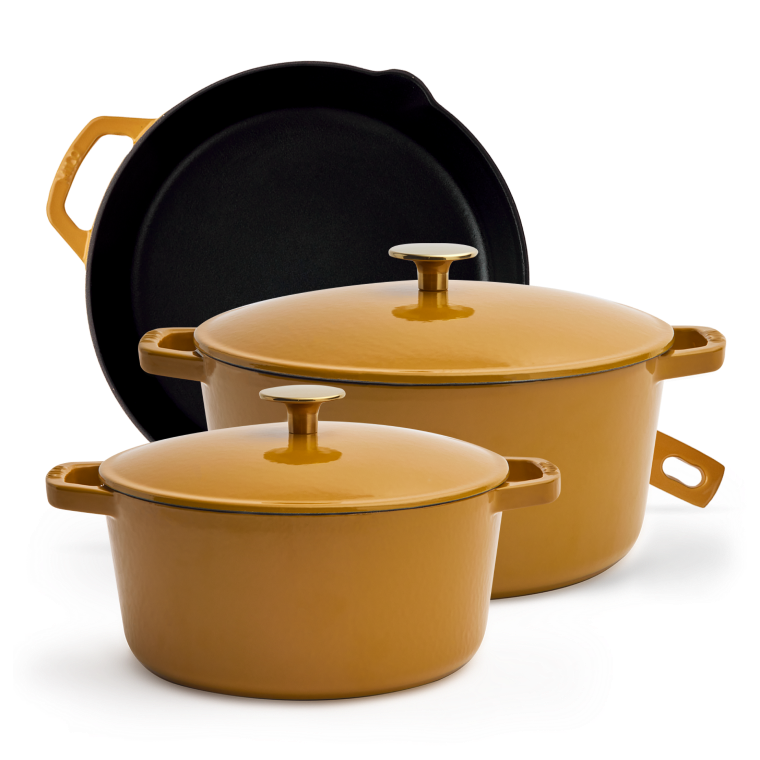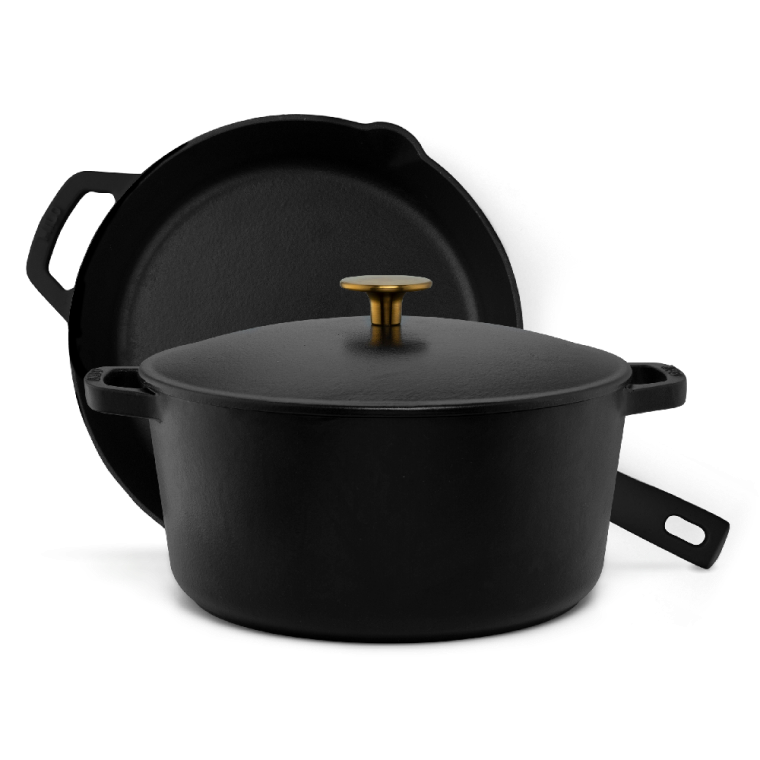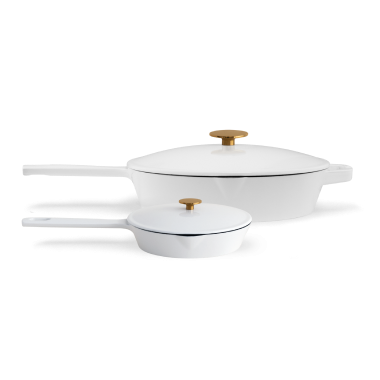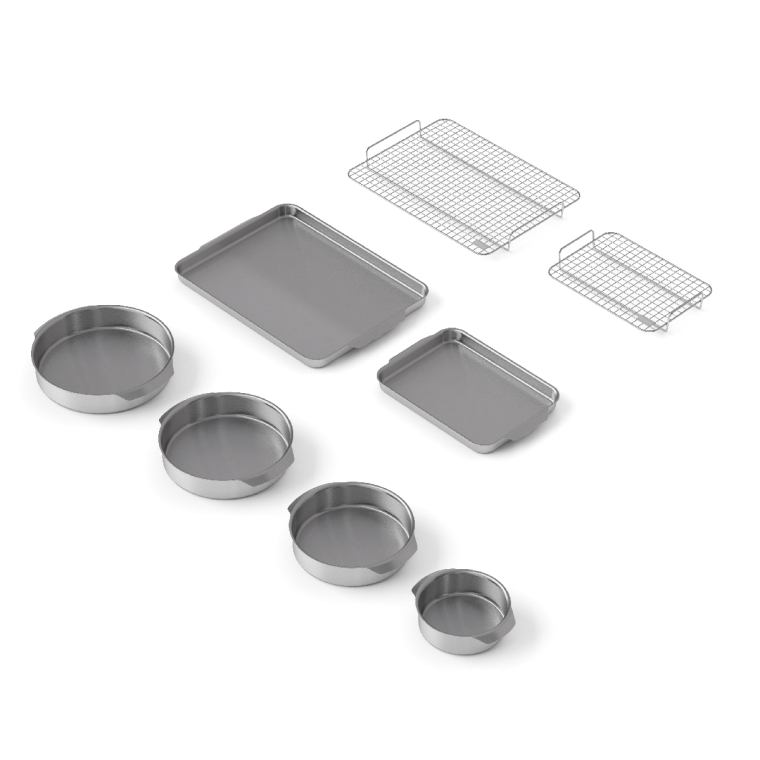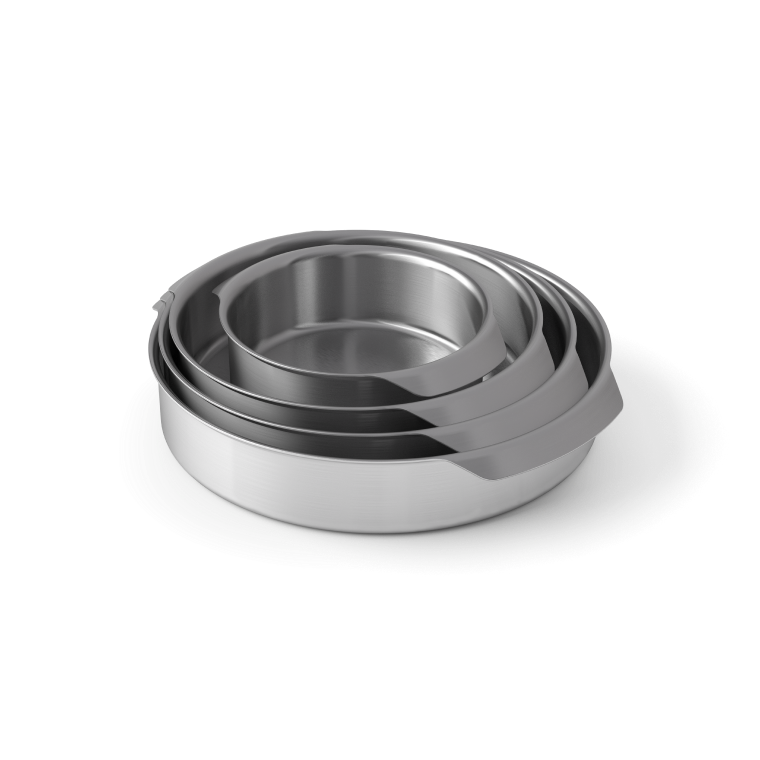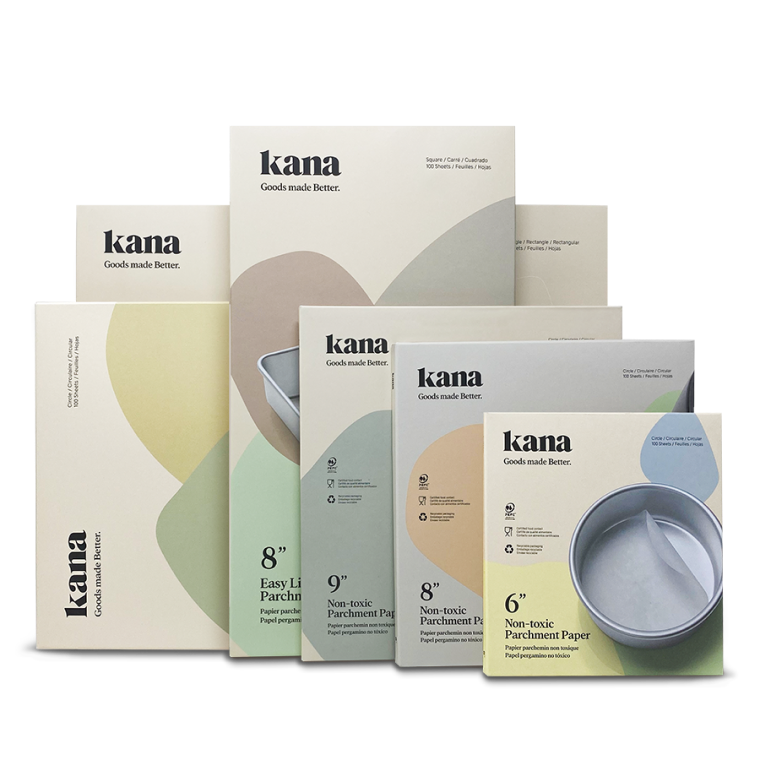
Hand Washing
1/4

Cool down
Before washing, wait until your Dutch oven is cool to the touch but not completely cold. Doing so makes it easier to remove scorched food or sticky residue while preventing cracks in enameled cast iron (tossing cold water on hot enamel can cause thermal shock).
2/4

Soap
Once your Dutch oven is cool enough to touch, add a small amount of dish soap and warm water to the pot.
3/4

Wash
Using a sponge or Swedish dishcloth, gently wash the interior and exterior of the pot. Do the same for the lid.
4/4

Dry
Once your Dutch oven is clean, rinse the pot and lid thoroughly under warm water and dry with a clean towel.

Dishwasher Friendly
1/3

Milo cookware can be safely cleaned in the dishwasher.
2/3
Avoid contact with other dishes and cutlery to prevent scratches during the cycle.
3/3
While dishwashing is a convenient option, it can also cause the enamel to dull over time. It's a great once-and-a-while solution, but nothing beats handwashing!

Heavy Stains and Burnt Food
1/3

Burnt food?
Whether cooking with enameled cast iron or stainless steel, you'll occasionally have to deal with burnt food that stains and scorches your cookware.
2/3

Soak
Let your cookware soak with hot or boiled water for 30 minutes to soften the stain.
3/3

Wash
Rinse it out then add a small amount of water. Scrub it with enamel-friendly products such as Barkeepers Friend or Mr. Clean Magic Eraser to get rid of sticky spots. Looking for a natural alternative? Add two tablespoons of coarse salt and water to your Dutch oven and gently work at the stained area with a soft dishcloth. The texture of the salt is tough enough to remove burnt food and stains but not so tough that it can damage the finish.

Use & care

Utensils
Milo is tough but not indestructible. Less abrasive tools such as wood and silicone are your cookware’s best friend.
Care about the rims
Every once in a while, add a little food-safe oil to the rim of the pot and lid. These areas are pre-seasoned and require an occasional coating.
Stacking
Stacking is the best way to save cabinet space. If you have our 3-piece set or 5-piece set, we recommend layering them with our multi-purposes felt trivets to avoid scratching.

It can take the heat!
Our cookware can be used on all types of cooking surfaces: gas, electric solid plate or radiant ring, ceramic, or induction. They're oven-safe for up to 500°F (260°C). If using a glass stovetop, take care to gently lift your cookware to prevent scratching.
Cookware products
SEE ALL COOKWARE PRODUCTSStill have questions?
CONTACT US
Hand Washing
1/4
Cool down
Before washing, wait until your bakeware is cool to the touch but not completely cold. Doing so makes safer as it will get extremely hot and it makes it easier to remove scorched food or sticky residue.
2/4
Soap
Once your bakeware is cool enough to touch, add a small amount of dish soap and warm water to the pan.
4/4
Dry
Once your bakeware is clean, rinse it thoroughly under warm water and dry with a clean towel.

Dishwasher Friendly
1/2
Milo bakeware can be safely cleaned in the dishwasher.
2/2
Ensure the tough and sturdy bakeware doesn't come in contact with stoneware during the cycle.
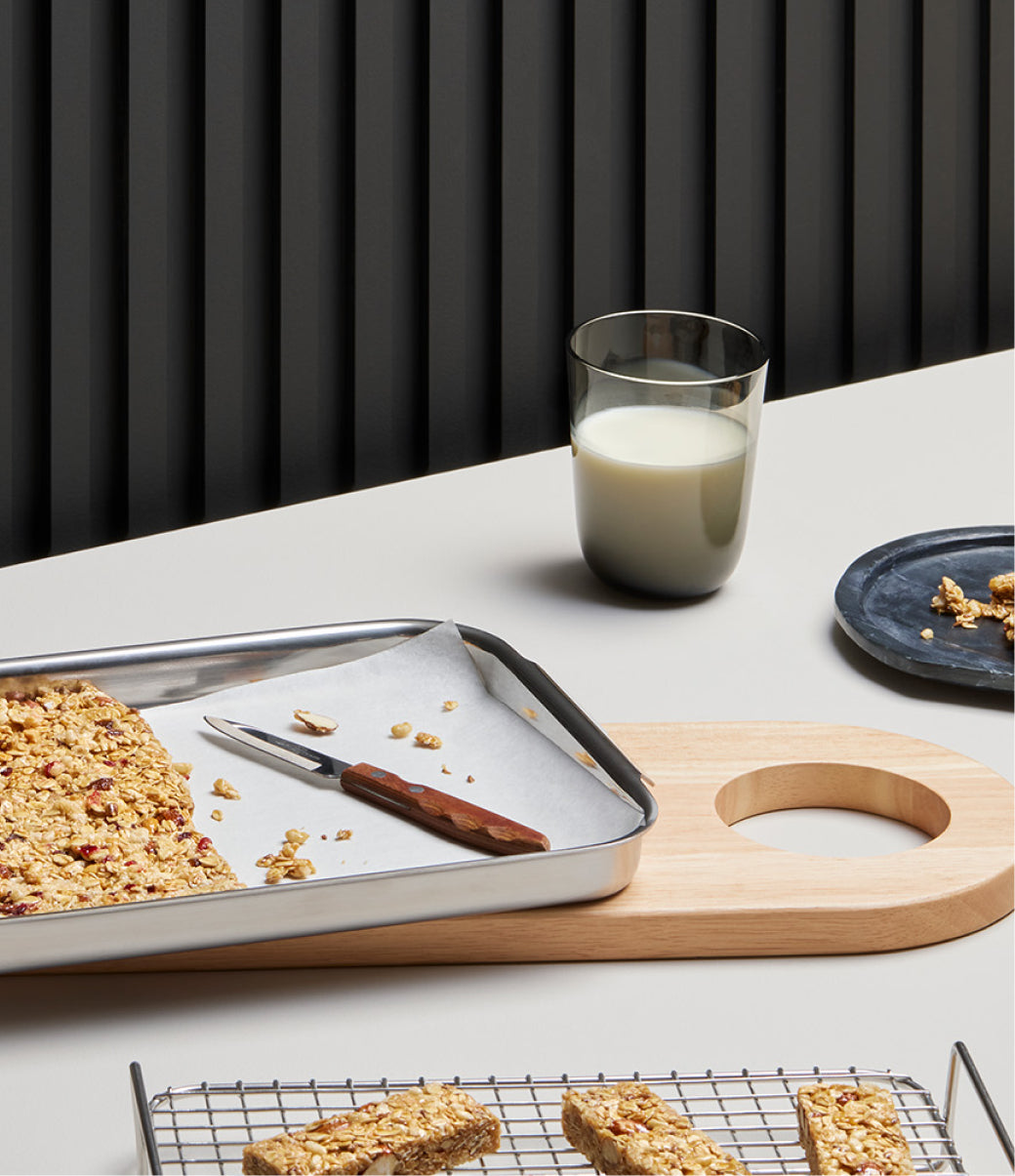
Heavy Stains and Burnt Food
1/6
Burnt food?
Whether cooking with enameled cast iron or tri-ply stainless steel, you'll occasionally have to deal with burnt food that stains and scorches your pan.
2/6
Soak
Let your bakeware soak with hot water for 30 minutes to soften the stain.
3/6
Wash
Rinse it out then add a small amount of water. Scrub it with enamel-friendly products such as Barkeepers Friend to get rid of sticky spots.
4/6
Wash: Natural Method
Option 1: For burned or burnished bakeware, use coarse salt and gently massage the surface, then scrub with a non-abrasive sponge. Baking soda and water also work well.
Option 2: Mix baking soda and a little water to make a paste. Spread the mixture evenly across the bottom of the pan, let it sit for a few minutes, scrub, and rinse.
5/6
Dry
Once your baking pan is stain-free, rinse the pot and lid thoroughly under warm water and dry with a clean towel.
Warning
Steel wool or chainmail scrubbers to clean tri-ply stainless steel is not recommended. As tempting as it may be, if you decide to do so, you will not impact the performance of your bakeware but it will result in leaving scratches on the stainless steel.

Use & care
Stacking
Stacking is the best way to save cabinet space. If you have the Cake bundle of the Starter bundle, we recommend our multi-purposes felt trivets. They have been specifically designed to be used as trivets but also pan protector for our cake pans. Our trivets come in pack of 3 all in different sizes to fit the interior of our cake pan perfectly.
2/2
It can take the heat!
Our bakeware is designed for traditional home ovens as well as commercial gas and convection ovens. It withstands temperatures up to 1,000°F (538°C) and so it is compatible with outdoor grill and is also flame resistant.
Cookware products
SEE ALL COOKWARE PRODUCTSStill have questions?
CONTACT US
Use & care
1/5

Oven safe
Thanks to a heat-resistant silicone coating, parchment paper is perfect for cooking. Our recommended maximum usage temperature is 428°F (220°C).
Tip: If you want to push it a little further, we conducted several tests and determined that our parchment paper can withstand up to 572°F (300°C) for 10 minutes, provided baked goods cover at least 90% of the paper’s surface area.
2/5
Fridge & freezer safe
Our paper withstands the cold, too, and is great for preserving food. Keep it in the fridge for up to 2 months and in the freezer for up to 12.
4/5
Reusable
Stay sustainability-minded and use the same sheet of parchment paper multiple times! Baked cookies, for instance, slide easily off the nonstick paper, inviting you to use the same sheet for the next batch. When the parchment paper becomes dry, browned, or brittle, it’s time to change it. Of course, when cooking high-water veggies or fatty food, single-use may be the way to go.
5/5
Compostable
Our parchment paper is certified biodegradable and compostable, so you can toss it in the compost with a clean conscious. It's also super convenient to wrap food waste with before disposal.
Parchment paper
SEE ALL PARCHMENT PAPER PRODUCTSStill have questions?
CONTACT US
Trivets: Wash
1/1
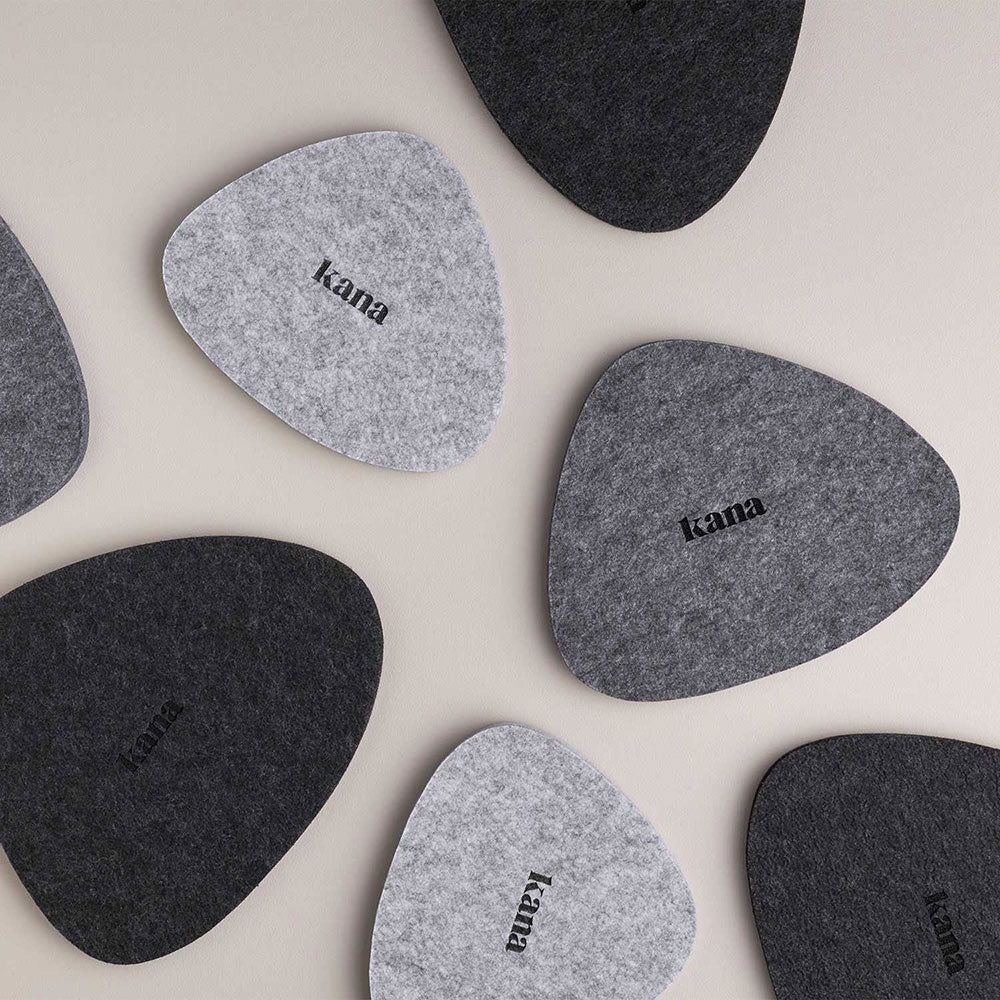
Wash
Spot clean with a damp cloth. Do not machine wash.

Trivets: Use & Care
1/3

Protects against heat
Prevents burn marks on your tables and countertops.
2/3

Protects against moisture
Prevents moisture marks on your tables and countertops. Use our trivets under your planters, soap dispensers, oil diffusers, or as a coaster.
3/3

Protect pots and pans
When stacking pots and pans to save space, prevent scratching by layering our trivets between your cookware.

Swedish dishcloths: Wash
1/4
Wash
Toss our Swedish dishcloths in either the dishwasher or washing machine - they are washable in temperatures up to 90°C / 195°F.
2/4

Dry
Lay the Swedish dishcloth flat to air dry.
Warning
Tumble drying is also safe but may reduce the lifetime of your cloth.

Bleach
Our Swedish dishcloths are resistant to chlorine bleach. Freshen them up with a ratio of 1/4 cup bleach and 2.5 quarts of water. Let soak for around 20 minutes.

Swedish dishcloths: Use & Care
1/2

No more paper towels!
Reduce waste and use our Swedish dishcloths as sustainable alternatives to paper towels.
2/2

Durable and disposable
Our Swedish dishcloths last up to 200 wash and can be disposed of in the compost bin—yes, they are certified compostable!
